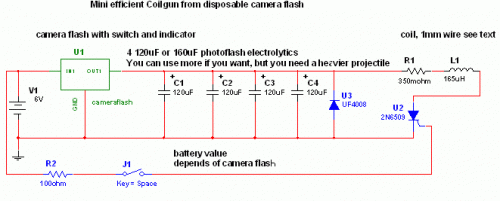Electronic projects |
|
|
|
you are here: home page :: projects :: Miscellaneous :: Miscellaneous :: Mini efficient coil launcher from disposable camera flash
Mini efficient coil launcher from disposable camera flash
Disclaimer: I don't accept any responsibility for the damages done with this device to peoples, things, animals, fragile things etc , if you build it, you must accept this condition.
This is a fun and non-dangeros project for those people who like to throw projectiles magnetically. It simply works by placing a ferromagnetic projectile at one end of a coil and pulsing some power in it. The trick is to switch off power when the projectile is at the middle of the coil, there are some ways to do it but it isn't important now. The second trick is to use a coil as close as possible to projectile to waximize coupling and the third to avoid saturation, that means keeping the current not to high. Concerning the charging circuit, use the largest you got, and try to use more batteries than originally if you want a fast charge. I used a max kodak disposable flash and it works fire with 4 1.5V batteries (originally it was designed to use one) and doesn't burn out. The caps where soldered on a small breadboard with parallel tracks made with lots of solder (otherwise the solder will blow). When placing the projectile the projectile starting position is critical, make various shots at different positions to see which is better. e-mail: jonathan.filippi@virgilio.it web site: http://www.electronics-lab.com |
 Audio (49) Audio (49) Power & high voltage (43) Power & high voltage (43) Radio (23) Radio (23) Light & LED (31) Light & LED (31) Tools & measurement (40) Tools & measurement (40) Telephone (18) Telephone (18) Automotive (10) Automotive (10) Microcontrollers (12) Microcontrollers (12) Sensors & control (47) Sensors & control (47) Timers & oscillators (40) Timers & oscillators (40) Miscellaneous (26) Miscellaneous (26)All subcategories Miscellaneous 7 Segment LED Counter Cuckoo sound Generator Digital Step-Km Counter Digital Stopwatch 0-60sec Digital Stopwatch 0-99sec Downed Model Locator Downed Model Locator II Economy radar detector Electronic Locker IR Remote Control Jammer Doorbell for the Deaf High Quality Intercom Combinational Conjuring Trick POT-PLANT POWER Ultrasonic Dog Whistle Quiz Circuit LED Torch Insect Repellant Speaker Microphone Circuit Magic Wand Conjuring Trick. Led display digital Voltmeter 500W low cost 12V to 220V inverter Low pass filter - Subwoofer Metal Detector High And Low Voltage Cut Off With Time Delay Basic UPS Power Supply 2N3055 Power Amplifier 200W audio amplifier LED Torch 100W RMS Amplifier DIY Electronics Projects  Promote Your Page Too |


